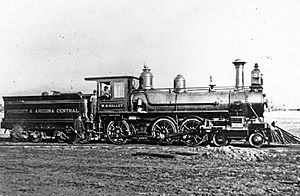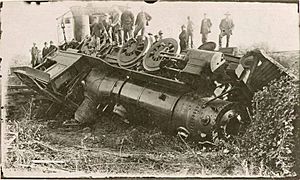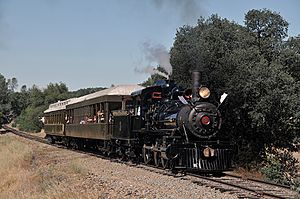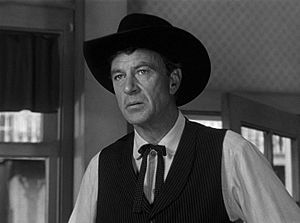Sierra Railway 3 facts for kids
Quick facts for kids Sierra Railway 3 |
|
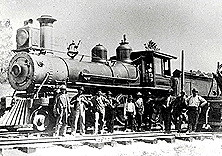 |
|
| Sierra Railway No. 3, circa 1904 | |
| Power type | Steam |
|---|---|
| Builder | Rogers Locomotive and Machine Works |
| Serial number | 4493 |
| Build date | March 26, 1891 |
| Configuration | 4-6-0 |
| UIC classification | 2'C |
| Gauge | 4 ft 8 1⁄2 in (1,435 mm) |
| Leading wheel diameter | 2 ft 2 in (0.660 m) |
| Driver diameter | 4 ft 8 in (1.422 m) |
| Boiler pressure | 150 psi (1.03 MPa) |
| Cylinders | Two, outside |
| Cylinder size | 17 in × 24 in (432 mm × 610 mm) |
| Valve gear | Stephenson |
| Valve type | Piston valves |
| Tractive effort | 17,470 lbf (77.7 kN) |
| Official name | W.N. Kelly |
| Retired | 1932 (revenue) |
| Current owner | Railtown 1897 State Historic Park |
| Disposition | Operational |
Sierra Railway 3, often called the "Movie Star locomotive," is a famous old steam locomotive. It is owned by the State of California. You can see it at Railtown 1897 State Historic Park in Jamestown, California.
This locomotive has appeared in more movies, documentaries, and TV shows than any other train. It is seen as the classic steam train that helped the USA grow from the 1800s into the 1900s. Built in 1891, the locomotive started running again in July 2010. This was after 14 years out of service and a three-year major repair. Its original boiler had to be replaced.
Contents
History of the Movie Star Train
No. 3 is a type of steam locomotive called a 4-6-0 "ten-wheeler." It was built by the Rogers Locomotive and Machine Works in Paterson, New Jersey. The train was finished on March 26, 1891. It was given the number 4493 by its builders.
The locomotive was first built for the Prescott & Arizona Central Railway (P&AC). It was their locomotive #3 and was named W.N. Kelley. This was after the company's treasurer.
The P&AC company went out of business in 1893. Its owner, Thomas S. Bullock, moved to California. He brought much of his railroad equipment with him, including No. 3. In 1897, he teamed up with Prince André Poniatowski and William H. Crocker. They started the Sierra Railway Company of California. Their goal was to connect Oakdale, California with areas in Tuolumne and Calaveras counties that produced timber.
Building the Railroad
The locomotive became Sierra No. 3 and dropped the W. N. Kelley name. It was very important in building the railroad to Jamestown, California in 1897. Then it helped extend the line to Sonora, California in 1899 and Tuolumne in 1900.
It was the main locomotive pulling freight trains until 1906. That year, the Sierra Railway bought a new Baldwin Locomotive Works 2-8-0 locomotive. Sierra No. 3 played a big part in moving timber, mining materials, and supplies for dam building in the Sierra foothills.
The locomotive was first built to burn coal. But between 1900 and 1902, it was changed to burn oil.
Train Incidents
Sierra No. 3 was involved in a few accidents. In February 1898, a switch problem caused the death of conductor William G. Bailey. In September 1899, its tender (the car that carries fuel and water) went off the tracks while backing up on a trestle. This caused the trestle to fall apart.
The locomotive tipped over in 1918 near Sonora. Its original wooden cab (the driver's area) was destroyed. A new steel cab, like those used by the Southern Pacific railroad, replaced it in February 1919. Two years later, Sierra No. 3 made its first known Hollywood movie appearance. This was in a silent film called The Terror, starring Tom Mix.
Surviving Hard Times
During the Great Depression, the Sierra Railway went bankrupt. It was reorganized as the Sierra Railroad Company in 1937. Sierra No. 3 was taken out of service in 1932. It sat in the Jamestown yard for 15 years.
It was lucky to avoid being scrapped during World War II. In 1946, Hollywood became interested again. David O. Selznick, who produced the movie Duel in the Sun, wanted to destroy the train in a crash scene. But the Sierra Railroad's Master Mechanic, Bill Tremewan, convinced the owners not to do such a "ridiculous" thing. Instead, crews repaired the locomotive for possible special trips and movie work.
After checking the boiler, it was found to be in good condition. However, its maximum safe pressure had to be lowered. The repairs were finished in 1948. The locomotive officially returned to service on May 30, pulling a special train.
A Star is Born
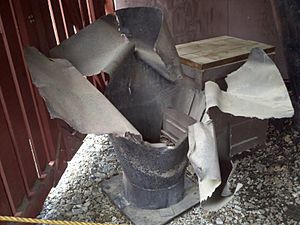
For the next 50 years, Sierra No. 3 pulled tourist trains. It also appeared in many films, TV shows, and commercials. Some famous ones include High Noon in 1952, which won Gary Cooper an Academy Award for Best Actor. It also appeared in Unforgiven in 1992, directed by and starring Clint Eastwood, which won the Academy Award for Best Picture.
The locomotive was often changed to look different for movies and TV. One of its most famous roles was the Hooterville Cannonball from the 1960s TV series Petticoat Junction. Fake smokestacks were also often added to change its look.
In 1981, the State of California decided to buy the railroad's facilities in Jamestown, including Sierra No. 3. The purchase was completed on September 15, 1982. Since then, the locomotive has been owned by the State of California. In May 1991, No. 3 visited Sacramento for Railfair '91. This event celebrated the tenth anniversary of the California State Railroad Museum.
In 1995, new safety rules for steam locomotive boilers were made. To follow these rules, Sierra No. 3 was taken out of service. A full check of the locomotive's condition was needed.
21st-Century Renovation
Initial repairs were done in 2000–2001 using state funding. This included taking the locomotive apart. The project moved slowly until 2007, when a big fundraising effort began. At that time, the repair cost was estimated at $600,000. This was based on the idea that the old boiler could be saved.
Clint Eastwood helped with fundraising. He called Sierra No. 3 "like a treasured old friend." Eastwood had ridden the locomotive early in his career for the TV series Rawhide. He later used it in his own movies, Pale Rider and Unforgiven.
Eastwood wrote that Sierra No. 3 is at Railtown 1897 State Historic Park. It is kept in the original roundhouse, which is still used. He said these two things offer a rare chance to see history as it was over 100 years ago. Many groups and people donated money for the renovation.
When work on the taken-apart locomotive started again, the boiler was checked carefully. It was found that a new boiler was needed. The old boiler's design made it too expensive to update to modern safety rules. Also, there was a risk of losing its historical look. So, the Railtown staff decided to get a new one.
The Strasburg Rail Road in Pennsylvania provided drawings and help to build the new boiler. The old boiler was sent to Chelatchie Boiler Works in Washington. They used it as a pattern to build a new, welded boiler for $600,000. The new boiler was then sent to the historic Southern Pacific shops in Sacramento, California. There, it was put onto the original frame of the locomotive. Finally, the locomotive was trucked back to Jamestown for its last assembly.
The locomotive now looks like it did in 1929. That year, the movie The Virginian was filmed. This was the first time the train's steel cab was clearly seen. The total cost of the rebuild was $1.6 million. The locomotive officially returned to service on July 3, 2010.
Movie Appearances
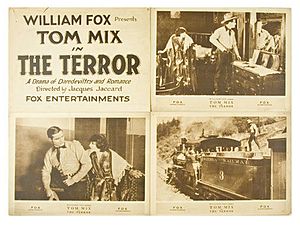
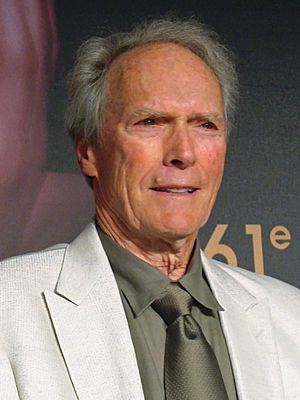
Sierra No. 3 has appeared in many movies. According to Railtown 1897, these include:
- The Red Glove, 1919
- The Terror, 1920, starring Tom Mix
- The Virginian, 1929, starring Gary Cooper. This was the first "talkie" (movie with sound) filmed on location.
- The Texan, 1930, starring Gary Cooper
- Young Tom Edison, 1940, starring Mickey Rooney
- Sierra Passage, 1950
- Wyoming Mail, 1950
- High Noon, 1952, starring Gary Cooper (who won an Academy Award for his role).
- The Cimarron Kid, 1952
- Kansas Pacific, 1953
- The Lone Hand, 1953
- The Moonlighter, 1953
- Apache, 1954
- Rage at Dawn, 1955
- The Return of Jack Slade, 1955
- Texas Lady, 1955
- The Big Land, 1957
- Terror in a Texas Town, 1958
- Man of the West, 1958, starring Gary Cooper
- Face of a Fugitive, 1959
- The Outrage, 1964
- The Rare Breed, 1966
- The Great Race, 1966
- The Perils of Pauline, 1967
- Finian's Rainbow, 1968
- A Man Called Gannon, 1968
- The Great Bank Robbery, 1969
- Joe Hill, 1971
- The Great Northfield Minnesota Raid, 1972
- Oklahoma Crude, 1973
- Nickelodeon, 1976
- Bound for Glory, 1976
- The Apple Dumpling Gang Rides Again, 1979
- The Long Riders, 1980
- Pale Rider, 1985, directed by Clint Eastwood
- Blood Red, 1986, with Julia Roberts in her first movie
- Back to the Future Part III, 1990, starring Michael J. Fox and Christopher Lloyd. This is one of its most famous roles.
- Unforgiven, 1992, directed by Clint Eastwood, and winner of the Academy Award for Best Picture
- Bad Girls, 1994
- Color of a Brisk and Leaping Day, 1996
TV Appearances
Sierra No. 3 has also appeared in many television shows. According to Railtown 1897, these include:
- The Lone Ranger, 1956
- Tales of Wells Fargo, 1957
- Casey Jones, 1958
- Rawhide, 1959–1966, starring Clint Eastwood
- Overland Trail, 1960
- Lassie, 1961–1962
- Death Valley Days, 1962–1965, starring Ronald Reagan
- The Raiders, 1963 TV movie
- Petticoat Junction, 1963–1970, where Sierra No. 3 pulled the Hooterville Cannonball
- Green Acres, 1965–1971, also pulling the Hooterville Cannonball
- The Wild Wild West, 1964
- The Big Valley, 1964–1966
- The Legend of Jesse James, 1965–1966
- Scalplock, 1966 TV movie
- Iron Horse, 1966–1968
- Cimarron Strip, 1967
- Dundee and the Culhane, 1967
- The Man from U.N.C.L.E., 1967
- Ballad of the Iron Horse, 1967 documentary
- Gunsmoke, 1971
- Alias Smith & Jones, 1971-1973
- Bonanza, 1972
- The Great Man's Whiskers, 1972 TV movie
- Inventing of America, 1975 documentary
- Little House on the Prairie, 1975–1983
- Law of the Land, 1976 TV movie
- A Woman Called Moses, 1978 miniseries about Harriet Tubman
- Lacy and the Mississippi Queen, 1978 TV movie
- Kate Bliss and the Ticker Tape Kid, 1978 TV movie
- The Night Rider, 1979 TV movie
- The Last Ride of the Dalton Gang, 1979 TV movie
- Belle Starr, 1980 TV movie
- East of Eden, 1981 TV miniseries
- Father Murphy, 1981
- The A-Team, 1984
- Bonanza: The Next Generation, 1988 TV movie
- The Adventures of Brisco County, Jr., 1993
- Ultimate Restorations Season 1, Episode 3, 10/20/2014


